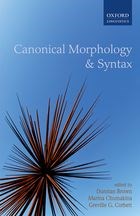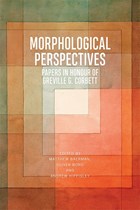Canonical Typology
Overview
The canonical approach to typology involves analyzing and defining phenomena which are subject to variability (across and within languages).
This is done by identifying and extracting data on the various scales along which we characterize variability. The scales themselves relate to the presence or absence of a property or characteristic, or the degree to which a a particular property is manifested by a particular set of data. These scales (called criteria) are structured such that when a dataset meets one of the criteria it is more canonical along that parameter than those datasets that do not. Part of the established canonical typological method involves establishing the logical end point of these scales, and thereby also identifying which properties are non-canonical.
By integrating these scales, we can construct theoretical spaces of possibilities in which hypothetical types, each characterised by a different permutation of variable combinations, is established as a logical possibility within a typological space. Only then do we investigate how this space of possibilities is populated with real instances.
To be a canonical instance of a phenomenon – that is, a clear and indisputable instance – means matching a full set of criteria associated with that phenomenon, and so it follows that such instances are likely to be at best infrequent or even non-existent (in accord with the ‘Anna Karenina Principle’, Diamond 1998: 157). This is therefore an axiomatic approach, which aims to ensure that we are aware of the full range of the phenomena we wish to account for, and have a metalanguage to describe them. It is justified entirely by utility and results, which have been encouraging to date. This brief statement is based on Corbett (2015); a more extended account of the method and several recent examples can be found in Brown, Chumakina and Corbett (2013).
Research in Canonical Typology
The Canonical Typology bibliography, comprising a list of publications and preprints, is available as a guide to ongoing work in Canonical Typology. It shows that Canonical Typology has progressed from its origins in morphology and syntax to cover a much greater range, including phonology and sign language.
An new edited volume on non-canonical gender is underway, as part of a collaboration resulting from the Worrkshop on Non-canonical Gender Systems held in Spetpember 2015 as part of the 48th Annual Meeting of the Societas Linguistica Europaea (SLE) at the University of Leiden.
A collection of papers, resulting from the workshop Creating Infrastructure for Canonical Typology, provides an introduction to the developments taking place in Canonical Typology:
Brown, Dunstan, Marina Chumakina & Greville G. Corbett (eds.) 2013. Canonical morphology and syntax. Oxford: Oxford University Press. Publisher's site
The following papers provide a useful overview of the main properties of the framework:
Bond, Oliver. 2019. Canonical Typology. In Jenny Audring & Francesca Masini (eds), The Oxford Handbook of Morphological Theory, 409-431. Oxford: Oxford University Press.
Corbett, Greville G. 2015. Morphosyntactic complexity: a typology of lexical splits. Language 91.145-193. Open access PDF
Round, Erich & Greville G. Corbett. 2020. Comparability and measurement in typological science: the bright future for linguistics. Linguistic Typology, 24.489–525. DOI: 10.1515/lingty-2020-2060 open access. PDF
TOP




